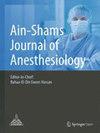The efficacy and safety of perioperative administration of dexamethasone: a systematic review and meta-analysis
IF 0.5
Q4 ANESTHESIOLOGY
引用次数: 0
Abstract
Abstract Background Perioperative prophylactic dexamethasone is commonly administered to reduce postoperative nausea and vomiting (PONV) and pain after surgery. In this study, we aimed to systematically review the efficacy and adverse effects of perioperative dexamethasone administration. Methods We conducted a systematic search until January 2023 in scientific databases, including PubMed, Scopus, Embase, Web of Science, and Google Scholar. After assessing the methodological quality of relevant studies, we synthesized those focusing on PONV, oral food intake tolerance, impaired wound healing, major postoperative complications, and postoperative infections following the perioperative administration of dexamethasone. Results A total of 27 studies were included in this systematic review and meta-analysis. The dexamethasone group showed decreased PONV (OR = 0.19; 95% CI 0.06–0.55), increased oral food intake tolerance (OR = 7.38; 95% CI 1.07–51.11), increased risk of impaired wound healing (OR = .48; 95% CI 0.52–4.21), decreased probability of postoperative infection (OR = 0.61; 95% CI 0.51–0.72), and increased risk of major postoperative complications (OR = 1.27; 95% CI 0.68–2.39) compared to the controls. Conclusions The results of our pooled data analysis showed that dexamethasone was superior to the control in terms of PONV, oral food intake tolerance, and postoperative infections.地塞米松围手术期应用的有效性和安全性:一项系统综述和荟萃分析
背景围手术期预防性地塞米松用于减少术后恶心呕吐(PONV)和术后疼痛。在本研究中,我们旨在系统地回顾围手术期给药地塞米松的疗效和不良反应。方法系统检索PubMed、Scopus、Embase、Web of Science、Google Scholar等科学数据库,检索截止至2023年1月。在评估相关研究的方学质量后,我们综合了那些关注PONV、口服食物摄入耐受性、伤口愈合受损、术后主要并发症和围手术期给药地塞米松术后感染的研究。结果本系统综述和荟萃分析共纳入27项研究。地塞米松组PONV降低(OR = 0.19;95% CI 0.06-0.55),增加口服食物摄入耐受性(OR = 7.38;95% CI 1.07-51.11),伤口愈合受损的风险增加(OR = 0.48;95% CI 0.52-4.21),术后感染概率降低(OR = 0.61;95% CI 0.51-0.72),术后主要并发症的风险增加(OR = 1.27;95% CI 0.68-2.39)。结论综合数据分析结果显示,在PONV、口服食物摄入耐受性和术后感染方面,地塞米松优于对照组。
本文章由计算机程序翻译,如有差异,请以英文原文为准。
求助全文
约1分钟内获得全文
求助全文

 求助内容:
求助内容: 应助结果提醒方式:
应助结果提醒方式:


